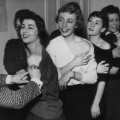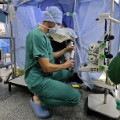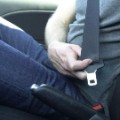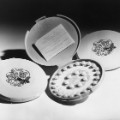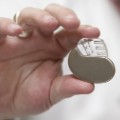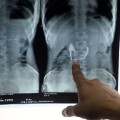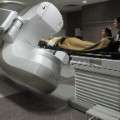Feb 24 2010 gma Andy passed
Friday, February 24, 2017
Tuesday, February 14, 2017
Students at liberal arts college wear white puzzle piece pins to remind themselves of white privilege
- Campaign was launched by college Democrats at Elizabethtown College in Central Pennsylvania
- Organizers say the point of the project is to encourage people to talk about race and white privilege
- It was inspired by a Lutheran pastor in Wisconsin, who has pledged to wear a white pin for a year
- Founded in 1899, Elizabethtown College has about 1,800 undergraduate students, of whom 86 per cent are white
PUBLISHED: 16:04 EST, 14 February 2017 | UPDATED: 17:43 EST, 14 February 2017
Students at a small liberal arts college in Central Pennsylvania are wearing white puzzle piece pins this month to raise awareness of white privilege and its impact on people of color.
The Elizabethtown College Democrats launched a project over the weekend called the 'Personal Identity Campaign,' which revolves around the question - 'How does race affect my life, directly and indirectly.'
The organizers of the campaign, which officially kicked off on campus Saturday evening, say that wearing the white pin will serve as a reminder of the 'struggles' associated with racial identity.

Symbol: Elizabethtown College Democrats have launched a campaign encouraging students to wear these white puzzle piece pins to kick-start a conversation about white privilege

Overwhelmingly white: Elizabethtown College, located in Central Pennsylvania, has about 1,800 undergraduate students, of whom 86 per cent are white
Founded in 1899, Elizabethtown College has about 1,800 undergraduate students, of whom 86 per cent are white.
The school's 203-acre campus is stated in Lancaster County, where according to the latest US Census data from 2015, more than 90 per cent of the population is white.
Aileen Ida, president of the College Democrats who is spearheading the white pin campaign, tells Lancaster Online that the goal of the project is to get people to talk openly about race and white privilege.

Leader: Aileen Ida, president of the College Democrats, says the goal of the project is to get people to talk openly about race
According to Ida, who is Caucasian, all white people inherently benefit from white privilege, whether they like it or not, but few pause to think about the effect it has on their lives and the lives of minorities around them. Her organization is hoping to change that, one puzzle piece at a time.
‘People of color have to every day wake up and think about race,’ Ida told Local 21 CBS last week. ‘They have to think about how it affects their life, what they have to do for it to not negatively affect their life, and as a white person, we don't usually have to think about that.’
Ida's group tweeted on Tuesday that so far, 50 students, alumni and people in the community have made a pledge to wear the puzzle pins for one month.
Ida pointed out that the purpose of the pin project is not to malign white people because of the color of their skin, but rather to encourage everyone to reflect on racial identity.
According to the college Democrats’ official Facebook page, the campaign was inspired by Barb Girod, a white Lutheran pastor from Wisconsin, who made a commitment to wear a white puzzle piece pin every day for a year 'to force herself to think about her white privilege and the impact white privilege has on people of color.'

The campaign was inspired by Barb Girod, a white Lutheran pastor from Wisconsin, who made a commitment to wear a white puzzle piece pin every day for a year
Not everyone, however, appears to be on board with the project.
Facebook user Paul Lewis slammed the campus activists as 'crazy leftists' and likened the pins to Nazi-era yellow ‘Jude’ stars.
'I love being white and am proud of my Italian-American heritage...everyone should be proud of their race and embrace it,’ he wrote in a comment on the group’s page.
Another commenter pointed out that the group has chosen the puzzle piece a symbol of white privilege, even though puzzle pieces are most commonly identified with Autism awareness.
Read more: http://www.dailymail.co.uk/news/article-4224966/Students-wear-pins-remind-white-privilege.html#ixzz4YikwLXSY
Follow us: @MailOnline on Twitter | DailyMail on Facebook
Who's the mystery child in this 103-year-old Floating Hospital photo?
By Robert Jimison, CNN
Updated 7:21 AM ET, Tue February 14, 2017
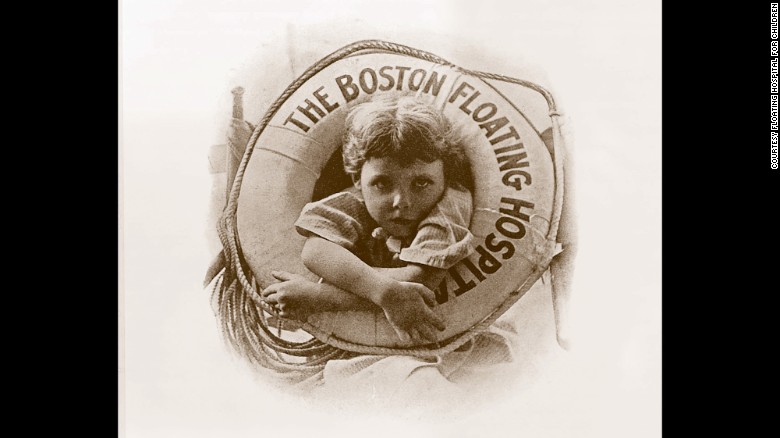
Tufts Medical Center staff members are hoping to identify the child in this 1914 image.
Story highlights
- A 1914 image promoted the Floating Hospital for Children in Boston for decades
- Tufts Medical Center staffers now hope to identify the mystery child in the image
(CNN)His face is known to all who work at the Floating Hospital for Children in Boston and familiar to many in the community -- but nobody can tell you his name.
In the black-and-white image from 1914, an unidentified child pokes his head through a life preserver with the words "The Boston Floating Hospital" around the rim. More than 100 years after the photo was taken, staff members at Tufts Medical Center are trying to discover who he is.
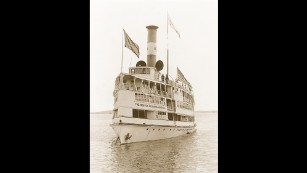
The Floating Hospital began on a boat in 1894 and expanded to a larger ship in 1905.
"This particular photo has been used by the hospital for promotional purposes and for fundraising, and unfortunately, we don't know the child's name," said Daniel Bird, the director of volunteer services and "unofficial historian" at Tufts Medical Center.
Bird has become fascinated with the image of this boy, who became the face of the academic medical center.
The Floating Hospital for Children literally started on a boat in 1894, Bird said.
"Back in that era, there wasn't anything like what we might call pediatrics. There was no natural medicine or cures for most of the childhood diseases and illnesses," Bird said.
The ship was destroyed by a fire in 1927, with no patients on board. It reopened on land, and today, the pediatric hospital is a 128-bed facility in downtown Boston. But the image of the child and the life preserver serves as a reminder of the hospital's origins.
"That photo kind of goes back to our roots," Bird said. "It's still an attractive photo. It's still one that's impactful and one that most people would recognize."
So, who is the boy in the buoy?
The photographer is unknown, and the photograph itself does not provide many clues. The back of the image reads "boy in life preserver photo taken aboard the floating hospital." At the time, many children had their photo taken on the boat, as a sort of souvenir.
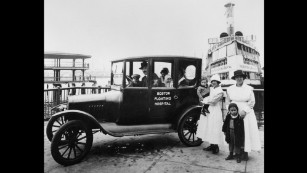
In a historic image, the Floating Hospital ambulance sits before the hospital ship.
"It was a staff photo, and it would be whoever was free at the moment would've taken the pictures," he said. "A lot of different children would get it, so it was not attributed to a professional photographer."
Though there is not much to go on, Bird believes that the face belongs to a Boston native. At the time of the photo, most visitors on the ship were residents of downtown Boston or the South End, rather than greater Boston or New England.
Join the conversation
"Even though it's now over 100 years old ... maybe he had children and grandchildren who may have heard of the story," Bird said. "We could identify it and maybe give some recognition to that little boy and the family."
Although there haven't been any leads since he took on this project late last year, 70-year-old Bird remains optimistic.
"Because Boston's a relatively tight community, it's not far-fetched to think we might be successful in identifying this little boy," he said.
Anyone with information about the child in the photo is asked to contact hospital spokesman Jeremy Lechan at jlechan@tuftsmedicalcenter.org.
Subscribe to:
Comments (Atom)





















